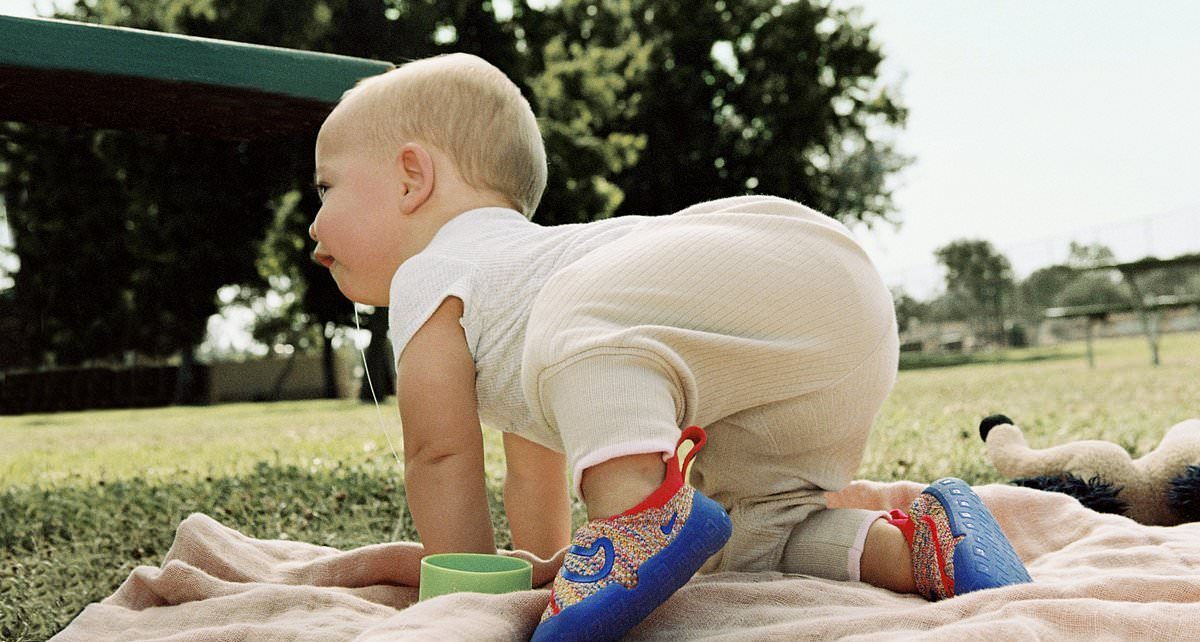‘A very expensive pair of socks!’ Nike faces backlash over ‘unnecessary’ and ‘questionable’ £45 baby trainers that podiatrists warn could hinder walking
- Podiatrists say babies do not need to wear shoes at all as it can hinder their gait
- New Nike baby trainers are approved my American podiatrists, sports giant says
Nike’s new ‘unnecessary’ baby shoes have been criticised by podiatrists.
The £45 trainers, which have been labelled a ‘very expensive pair of socks’ on social media, could hinder walking and disrupt balance, experts have warned.
Although Nike says its baby shoe is ‘crucial for early walkers’ and designed to ‘promote natural gait development’, it’s best for babies to walk barefoot, according to Rob Payne, a leading musculoskeletal podiatrist from the London Podiatry Centre.
Mr Payne, who has worked with Premier League football clubs and Olympic athletes, said ‘the necessity of wearing trainers is questionable’ for babies.
‘Walking barefoot or in socks offers the advantage of enhancing a baby’s proprioception and refining their gait.

Nike says its baby shoe is ‘crucial for early walkers’ and designed to ‘promote natural gait development’

Podiatrists say babies do not need to wear shoes and ill fitting shoes can hinder a child’s gait
‘Introducing firm-soled trainers at this early stage may hinder proprioception due to the increased rigidity of the shoe, potentially affecting balance,’ he told The Telegraph.
The sports giant states the shoe, which was released on October 31 and costs £44.95, has a ‘seamless Flyknit upper’ that ‘provides 360 degrees of pliable support’.
It can bend in all directions and has a wide toe box to allow the feet to move like they were barefoot and the toes to splay and flex naturally.
The lightweight shoes are the first Nike children’s shoe to receive the American Podiatric Medical Association Seal of Acceptance, according to the company.
But not all parents posting on X, formerly known as Twitter, are sold.
They said: ‘So, Nike expects us to drop [money] on shoes that mimic carpet for babies learning to walk? That sounds like a very expensive pair of socks.’
One person commented on Nike’s Instagram post advertising the trainers and said: ‘Kids shouldn’t even be wearing shoes at that age, they haven’t developed and need contact with the earth, all you’ll be doing is binding the poor child’s feet.’
But others said the shoes looked ‘cool’ and made the baby in the advert look like a ‘future athlete’.


Nike says the shoe can bend in all directions and has a wide toe box to allow the feet to move like they were barefoot and the toes to splay and flex naturally. The lightweight shoes is the first Nike children’s shoe to receive the American Podiatric Medical Association Seal of Acceptance

Children’s shoes should allow space for the foot to grow, have adjustable fastenings, a flexible sole and not slip off the foot during walking, says Royal College of Podiatry
Although shoes can offer the feet protection, introducing them too early can ‘hinder a baby’s gait development’, Mr Payne said.
He added: ‘Given it is generally recommended for babies to learn to walk in safe indoor environments, reducing the likelihood of prolonged exposure to hard surfaces like concrete, such trainers do not seem necessary’.
Podiatrists usually advise parents to not put their babies in shoes at all, as ill-fitting shoes can damage the growth of muscles and soft bones in the feet.
The bones in the feet don’t become fully developed until a child is seven or eight and begin as cartilage, meaning they are soft and pliable.
It is vital to allow babies’ feet to develop as naturally as possible ‘free from the constrictions of footwear’, according to the Institute of Chiropodists and Podiatrists.
It only recommends shoes be worn from the point a child is ready to walk outside, as walking barefoot strengthens muscles in the feet.
Shoes should also allow space for the foot to grow, have adjustable straps, a flexible sole and not slip off the foot, according to the Royal College of Podiatry.
Source: Read Full Article



